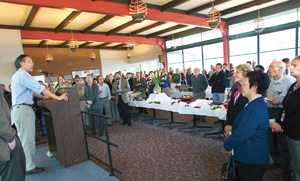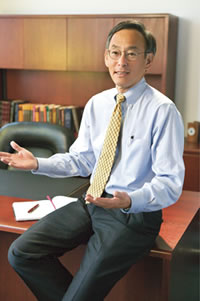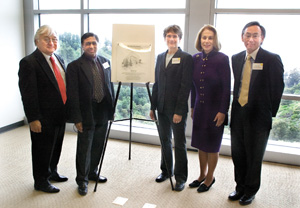Berkeley Lab at 75: A New Chapter of Achievement
What was it, Nobel Laureate Steven Chu was asked by a reporter, that got him to leave the relatively cozy world of research at Stanford University to face the bureaucratic rigors of management as director of Lawrence Berkeley National Laboratory?

Director Chu addresses Lab employees in the cafeteria after the Department of Energy announced that the University of California will continue its management of the Lab.
“I had roughly a third of my career left,” he told the reporter. “I thought, ‘Should I be doing other things?’ I was feeling a greater pull toward the energy problem and what could be done about it. I was also concerned that UC Berkeley’s physics department was in danger of slipping, and that it needed to stay in the leagues of the Harvards and the Stanfords.”
In the end, he said, he decided to “step into the cauldron,” and in August of 2004, he took the reins of what he described as a “national treasure,” a research environment that over its eight decades had built an impressive legacy of seminal contributions to science. At its heart was Ernest Lawrence’s collaborative approach to science, and Chu vowed to make this culture of interdisciplinary problem-solving even better.
The problem of energy supply, and of finding and developing carbon-neutral, self-sustaining, environmentally benign sources of power, Chu labeled “the single most important societal problem that science and technology must face.” And he pledged to marshal Berkeley Lab’s strengths in biological, chemical and computational sciences, its world-class facilities, its distinguished corps of engineers, and its pioneering initiatives in nanotechnology and synthetic biology to lead this country’s efforts at maintaining its competitive edge while mitigating the effects of global warming.
When he walked through the door, however, Chu discovered an immediate and significant threat to his plans. For the first time in its history, the Laboratory faced possible separation from its manager and guide, the University of California. Under new procedures established by the federal Department of Energy, science labs like Berkeley’s would now have to compete their management contracts among all bidders.

Berkeley Lab Director Steve Chu.
Potentially without UC at the helm, Chu knew his tenure at Berkeley Lab might be brief indeed.
So he assembled a mighty team of Lab senior managers and staff, working with UC advisers from the President’s Office, to build the case for continued UC management. What resulted in spring 2005 was the DOE’s unanimous decision to maintain the relationship, convinced as they were that the leadership of Nobel Prize-winning physicist Chu, plus the Lab’s extraordinary resources and strong partnerships with UC Berkeley, UC San Francisco and other institutions, promised exciting opportunities ahead.
Such promises were given a boost on March 24, 2006, when the 94,500-square-foot Molecular Foundry was dedicated and then began operations as the most advanced nanoscience research facility in the nation. Focusing on fabrication strategies for both inorganic and organic materials, the new facility — one of five funded by the Department of Energy’s Office of Science — was poised to deliver such tantalizing prospects as electronic devices made out of carbon nanotubes, compounds to detect and treat disease at the cellular level, and sensors for real-time monitoring of chemical and biological activity.
Next-generation solar cells were also on the Foundry’s to-do list, which would fit nicely into Chu’s visionary energy program called “Helios.” That was his umbrella term for Berkeley Lab’s quest to develop abundant and inexpensive solar-based energy technologies. As Chu’s term as Director entered its third year, he was busy securing valuable alliances with academia and industry, poised to compete for financial support to carry out his ambitious initiative. As more and more experts, including those at Berkeley Lab, cited evidence of a global warming trend that could lead by century’s end to water and energy shortages and even deaths, Berkeley Lab rallied its expertise for the challenge.
The Director had another priority that dominated his first years in office — safety, and the need to improve it. “We have to change the culture here to incorporate safety into everything we do,” he told an all-hands meeting in early 2005. Despite the Lab’s solid record of safe performance, the Office of Science demanded better, with a standard to which most industrial labs are not held. This “zero tolerance” message, punctuated by safety reviews and training, reverberated through laboratories and offices alike.

The Molecular Foundry dedication included (from l-r) U.S. Representative Mike Honda, Altaf Carim, with the Office of Science, Foundry Director Carolyn Bertozzi, State Secretary of Business, Transportation and Housing Sunne McPeak, and Director Chu.
Berkeley Lab’s scientific progress would be dependent upon new ideas and contemporary buildings. Chu presaged what he had in mind when, on his first anniversary at the Lab, he said, “We would like to construct a hostel for the Lab’s scientific visitors, an energy/nanotechnology building, a computational sciences center, and an ALS user support building…We continue to push for the Joint Dark Energy Mission (JDEM) and our proposal for this mission, the SuperNova Acceleration Probe (SNAP).”
As if to prove the point, Saul Perlmutter, astrophysicist and SNAP Godfather, received two international prizes in 2006 for his efforts in identifying and measuring the expansion of the universe.
Chu continued, “Our Lab initiatives also include continuing efforts in quantitative biology, including exciting collaborations with researchers at UC San Francisco (with National Cancer Institute support); in health diagnostics, genomic analysis and application. Our physical scientists continue to probe the origins of matter and energy by developing and utilizing tools that can study the infinitesimally small — both particles and processes. The Advanced Light Source, a model user facility by any measure, will reinvent itself to remain effective and useful for many years to come, and the Joint Genome Institute is poised to become the international center for microbial sequencing.”

The cover of the Helios Project brochure.
Synthetic Biology, distinguished at Berkeley Lab by being the first department of its kind in the country, took on added importance when in March 2005 it moved into spacious, high-tech quarters in a biosciences building in west Berkeley. Jay Keasling, its leader, received a $42.6 million grant from the Bill & Melinda Gates Foundation to develop an affordable, accessible cure for malaria, one of the world’s most intractable diseases. Multidisciplinary efforts in cell and molecular biology, cancer research, and quantitative biology were also housed there.
With apologies to Yogi Berra, Chu has quoted the malaprop king on many occasions, saying, “Making predictions is very difficult, especially about the future.” But his forecast for Berkeley Lab, on the eve of its 76th year, was confident:
“My vision for the future of Berkeley Lab when I arrived, and remains now, is to be a model facility for connectivity across divisions, a creative and nurturing environment that develops and grows new initiatives and the talented people who make them happen.”
This is the last installment of the view’s historical series on Berkeley Lab.